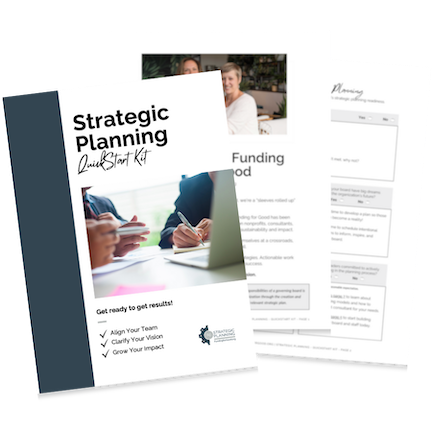Effective Communication Between the Executive Director and Board
Nonprofit leadership can be confusing and messy!
So how can the Executive Director and Board of Directors overcome differences and work together to ACHIEVE the organization’s goals? Before we dive into strategies for increasing effective communication, it is essential to understand some of those top goals.
Top 3 Shared Goals Every Nonprofit Leadership Team Should Strive to Achieve:
1. Understand the difference between board and staff roles and responsibilities.
- The core functions of the Executive Director (ED) and board are different. A board is a governing body that exists to provide oversight of the nonprofit’s activities. An Executive Director is responsible for overseeing the administration, programs, and strategic plans of the Nonprofit. It’s essential that each side fully understands their duties and shared responsibilities to avoid miscommunication and potential conflict.
- When a new board member is elected, they should participate in an effective onboarding process. This ensures they understand their legal and ethical duties and are empowered to lead. An intentional onboarding process will reinforce the expectation that every board member must ACTIVELY partner with the ED to achieve the mission.
- Before hiring an ED, the board should provide a current and realistic written job description. A good job description will outline performance benchmarks, the review process, and establish positive lines of communication with the board.
- The ED should provide consistent and relevant ways to inform the board about activities and engage the board in critical decision-making processes.
2. Establish clear, shared goals for your team.
A well-crafted strategic plan is the best “mediation tool” for a conflicted board and staff. The board should spearhead the strategic planning process with the support of the ED. In this way, everyone assumes a sense of ownership and can answer the critical question
“What next?
In addition to the strategic plan, it’s good to do an organizational assessment. A nonprofit leadership team should highlight potential strengths, weaknesses, opportunities, and threats that face the organization.
It is helpful to ask: “How can our ED and board work together to leverage our strengths/opportunities and overcome potential weaknesses/threats? This process, called a SWOT analysis, can be used to address issues at the organization, program, staff, or board level.
3. Commit to creating a positive work environment
Finally, the Executive Director and the Board should commit to actively contribute to the creation of a healthy, happy, and productive work environment.
It helps to acknowledge a few realities:
- Nonprofits are messy
- Fundraising can be terrifying
- The never-ending “to-do” lists can be exhausting
- Balancing expectations between a “volunteer board” and “paid staff” can be tricky
To this end, be intentional and consistent in the way you communicate. This will help you partner and hold each other accountable for achieving the organization’s mission.
Now to dive into an often complicated yet vital relationship between a Nonprofit Board and its Executive Director
We all know that a board of directors (BOD) is comprised of volunteers. A board governs the organization and is responsible for hiring and firing the Executive Director (ED). The ED is responsible for the daily management of operations. Executive Directors works with staff to ensure that programs and services fall within the scope of the nonprofit’s mission.
Sounds simple right?
If only life in the nonprofit world could be that easy! Instead, we find that many organizations have a BOD and ED that feel more like bickering partners than productive colleagues.
Lack of clear communication and shared goals leads to stress, frustration, hurt feelings, inefficient processes, disengagement, and an overall dysfunctional relationship. Much like a bickering couple who forget their children are in the room, boards and administrators often fail to recognize how their relationship impacts their nonprofit and the community they serve.
A significant challenge for an Executive Director is learning how to balance a productive yet respectful relationship with the board of directors. Boards, on the other hand, struggle to find the balance between “governing from a distance” while still having an “intentional and ACTIVE role” in the nonprofit’s development.
Understanding is not enough. Action is a must.
In recent years, board members reported that they contributed an annual average of 172 hours in service to their nonprofit. That is nearly 15 hours per month!
So where is all that time going?
More than half of respondents indicated that their volunteer hours are consumed by oversight of the mission and finances. Very little time was spent with “hands-on tasks, such as engaging grassroots supporters around public policy issues.” -2017 national survey by Hedrick and Struggles Association Leadership Council
Many EDs fear “scaring off their board by asking them to roll up their sleeves.” However, nonprofit trends indicate that more board members disengage because of the lack of “meaningful work” than because of being “overworked.”
How does a nonprofit take the first step?
Invite the Board of Directors and the Executive Director to engage in an honest conversation about the Nonprofit’s vision and mission. Explore ways to reach those goals together. Remember, the vision statement highlights “where you are going as an organization/community,” and the mission explains “how you are going to get there.” A focused and participatory conversation is essential. It helps leadership understand how every team member’s passions and skills connect them to the vision and how each is committed to achieving those shared goals.
Like any good relationship, everyone must be willing to give and take. If you believe your nonprofit leadership has a dysfunctional relationship, then start with an honest review of how your board and ED interact. Establish written operating principles and display them in a visible location at the organization. Those operating principles should clearly state the organization’s values and expectations for how all members of the BOD, staff, and volunteers should interact while working to accomplish the mission.
Why does each person take time out of their busy schedules to attend monthly board meetings, review organizational documents, or roll up their sleeves to help with fundraising events?
When asked why they serve (and offered the option to choose multiple responses), 91% of association and nonprofit board members said it is because they support the mission of the organization, and 68% agree with the statement “I believe I could make the organization more effective with my board involvement.” (2017 national survey by Hedrick and Struggles Association Leadership Council)
Once a team answers the question “why,” it is time to move on to the “how” portion of board engagement. How does the board need to receive information about the organization, recommendations from the ED, or invitations to engage? Below are a few practical tasks to clarify possible next steps and establish nonprofit norms.
Quick Tips for Boards that are Ready to Overcome Differences and Achieve Goals:
- Evaluate your board’s diversity, skills, availability, passions, and priorities.
- Clarify your process for identifying, recruiting, and approving new board members.
- Create a comprehensive onboarding process. Make sure all board members understand their roles and responsibilities. Be open and honest about expectations for board members.
- Establish norms for communication with your ED.
- The Executive Committee will meet most frequently with the ED to work through priorities. All mandates should come through the committee.
- Individual board members should not have the authority to walk into the organization and dictate to the ED and staff how they should perform their jobs.
- Outside of the board meeting, board members are ambassadors of the organization and volunteers, NOT individual supervisors of the ED.
- If a board member has a concern or suggestion, it should be brought directly to the BOD so that the Executive Committee can work with the ED on resolutions.
- TRUST in the skills and recommendations of the ED. The BOD hired them and should allow them to operate within their full capacity.
- Avoid excluding the ED from conversations if the ED will be called upon to take a specific action. In other words, allow the ED to engage in the conversation unless the discussion is specific to their internal performance review. The ED should be present to represent the client, staff, and administrative perspectives. Exclusion often leads to ill-informed decisions.
- Complete a wellness check-up with your ED. What do they think about the priorities, staff, and resources? How is their interaction with the BOD? What do they think about their personal ability to move forward with set goals?
- Create a PROACTIVE, not a REACTIVE environment at your board meetings. Gatherings should not force the ED or board into a defensive mode but should focus on solutions and celebrations.
Quick Tips for the ED:
- Remember that your board of directors are VOLUNTEERS. They care about the organization but may not have all the skill sets to do everything right all the time.
- Invite board members to a coffee or one-on-one gathering to pick their brain to learn WHY they said yes to joining the board.
- Build a relationship with board members that extends beyond the monthly agenda! (need a sample agenda, click here)
- Develop a “Board Engagement Form” that allows board members to indicate their individual strengths and areas they wish to volunteer. Be sure to ask what contact methods they prefer and their availability.
- Initially engage board members in the areas they feel most confident and then offer opportunities for growth and development.
- Always acknowledge the board’s efforts and provide encouragement and resources so they can continue to develop.
- Include a 2-3 minute engagement activity at the beginning of each board meeting. For example:
- Instruct the board and staff to move around the room and ask/answer a question. Something like, “What skills/perspective do I believe I bring to this board” or “What I most would like to see our organization achieve this year is ____.” After everyone takes their seats, request that a few board members share the responses they received.
- Allow a few board members/ staff to complete the following statement: “This board/staff could help equip me in my position by _________. If the board prefers more anonymous input, consider asking board members/staff to write their responses on an index card and pull from those cards at each board meeting. Those index cards serve as the board’s acknowledgment for areas that need development! Take time to listen and then address those requests.
Remember, building relationships and TRUST between the ED and Board of Directors is vital to effective leadership at any Nonprofit Organization. When you have clear communication of roles and responsibilities and meaningful board contributions, you achieve goals and fulfill the mission and vision of the Nonprofit and community you serve.
Related Articles you might want to check out:
As always, Keep Growing for Good!



